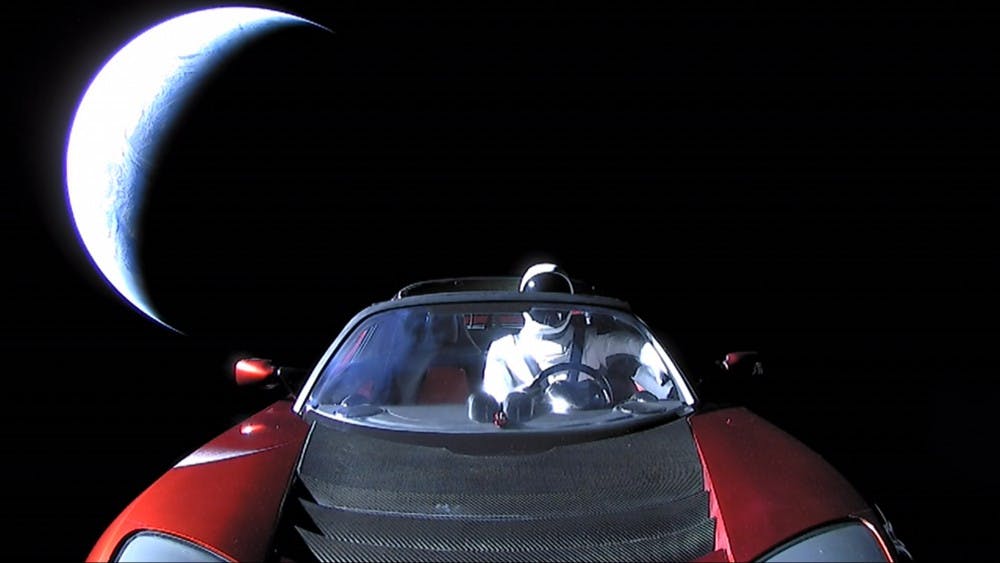Earlier this month, SpaceX dominated headlines with the launch of its Falcon Heavy rocket.
Among the many interesting aspects of the monumental launch, the rocket’s payload stood out. Painted a shade of red named “midnight cherry,” the personal Tesla Roadster of SpaceX CEO Elon Musk was aboard the rocket when it lifted off.
With millions watching the livestream worldwide, the test launch at Kennedy Space Center successfully launched the payload and returned the reusable side boosters. The test payload was Musk’s Tesla Roadster “driven” by a mannequin in an astronaut suit.
SpaceX planned to build the Falcon Heavy in 2011, primarily made using three Falcon 9s, SpaceX’s signature rockets. The original predicted launch date was back in 2013.
“We tried to cancel the Falcon Heavy program three times at SpaceX, because it [was] way harder than we thought,” Elon Musk, CEO of SpaceX, said in a press release after the launch.
The spacecraft company claims that the Falcon Heavy is able to launch 64 metric tons into orbit, making it the most powerful operational rocket in the world.
Many across the Hopkins campus were captivated by SpaceX’s latest achievement.
David Samson, president of the JHU Robotics Club, shared his experience watching the launch.
“I actually did watch it live, in Senior Design, and there were a good eight or so people sitting around and watching,” Samson said in an interview with The News-Letter.
Other students shared how excited they were to watch the livestream.
“The launch really inspired a lot of people, it had visible effects,” said Stéphane Testé, president of the Hopkins Rocketry Club. “We were expecting six people at the interest meeting, but 45 people ended up coming. People are visibly excited with the improvements going on in space.”
The Falcon Heavy’s rather unique payload has prompted some to ask exactly how well a car would fare in the rather harsh environment of space.
William Carroll, a chemist from Indiana University and a plastics and organic molecules expert, told Live Science that he is not so worried about the vacuum of space itself.
Carroll said that although humans are not suited to be in a vacuum, this is beause of the body’s internal pressures rather than any inherently dangerous effects of a vacuum.
According to Carroll, the most destructive forces acting on the car are radiation and solid-objects. If the car’s almost inevitable collisions with micrometeoroids do not destroy it, then radiation eventually will.
Since the Roadster is no longer driving along Earth’s roads, it now lacks the protection of the atmosphere and magnetic field that shield the planet’s surface from radiation.
“All of the organics will be subjected to degradation by the various kinds of radiation that you will run into there,” Carroll said, according to Live Science.
The organic substances that a car is composed of, including plastics components and a carbon fiber frame, are highly vulnerable to the radiation in space.
As Carroll explained, the radiation will force the carbon-carbon and carbon-hydrogen bonds of the Tesla’s organic materials to snap, causing it to fall apart.
The radiation would cause organic materials to discolor and flake, eventually splintering away. Since the Roadster is completely exposed to the sun, it would break down even faster. In fact, Carroll makes a claim that the car would not last a year.
The materials that contain the fewest number of bonds will be destroyed first. Any organic substances shielded from the radiation by non-carbon-bonded, inorganic material will likely last longer, but not forever.
The plastic in the windshield will also eventually discolor and fall apart. Plus, although carbon fiber pieces will last the longest, they eventually confront a deteriorating fate as well.
Once the radioactivity subsides, there would be nothing left of the car except for its inorganic components such as the aluminum frame, internal metals and certain glass parts.
Although many were ecstatic about the initial launch, Carroll is most excited to see what happens to the Roadster in the near future.























Please note All comments are eligible for publication in The News-Letter.